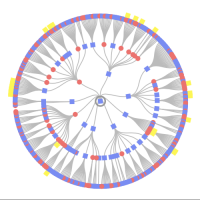140 year old glue - how to remove it.
I'm not sure this group is right for my question, but I have faith that, if not, someone will direct me to the right place eventually.
I have inherited a number of boxes of old stuff: papers, photo albums, you name it. One item is a business ledger with a large number of entries beginning 1831 (no typo, 1831!). Sometime after the Civil War the book was repurposed and many (but not all) pages have either newspaper clippings pasted on a page or what looks like pages from children's books. I have uploaded 3 images. One is of a good page where you can see the business record. Another has 1880 era newspaper clippings and I am peeling back a corner to reveal it is covering an 1831 business record. The last is a sample of the children's book. I want to remove the papers pasted on - hopefully preserving the newspaper clippings. I am not sure I care about the quality of the children's pages.
When I researched how to do this, I found this link http://www.ala.org/alcts/preservationweek/advice/glueadhesive. Is this the best advice?
And yes, if anyone is curious about the final disposition of this - I am in touch with multiple 2nd cousins and we will decide. This book was hidden for at least a century and was found in the back of my mother's closet after her death inside a box with other goodies no one has ever seen.
Also, my purpose: I want to grab all the names and dates and get them in a spreadsheet. I hope to put digital images of newspaper clippings into the appropriate ancestor records.
Thanks in advance for your advice!


답변들
-
I see I neglected to upload a sample of the newspaper clippings. Sorry.
0 -
This is an amazing account book—it looks like two I’ve seen from 1749-1800 (Laurence Ledger) and another from 1790-1800 (a store Ledger from Palmer Springs, Mecklenbug, VA) at Duke University. There is one online, Judge John Williams Account Book at Chapel Hill, NC.
Do you know yet who kept the Account Book and where he was living?
0 -
@Cherie Gardner Rawlings Thank you for your comment! I know where the book was in use, Washington township, Knox County, Indiana. Most ledger sheets have the town Bruceville written clearly at the top. Since there is no name of the owner I have 2 clues to go by as to which family owned it. First clue is a family surname (Thompson) is completely missing in the client list, and indeed the entire ledger except for one page where a debt was forgiven by a Thompson. This speaks volumes to me. Second clue is who inherited it. My great grandma, maiden name Thompson, was a Sunday school teacher who likely glued all those children's things. Unfortunately her father was a farmer and I doubt it belonged to him. But he had a slew of brothers, some of whom were quite prominent in the community. One of them is the owner, I suspect rather than her father. I am really frustrated that so far I have not been able to get any accountant, banking or financial person to look at it and tell me exactly what it is. There is not a single kind of commodity being documented (although all are bulk / wholesale rather than an in store transaction list). Also, services are documented, including the payment of the workers who dug wells or repaired wheels. So it looks almost like a ledger kept by a book keeping business to my uninformed eye. But certain clients are listed more often than others. Not sure why. Certainly the time it was in use, beginning 1832, was when Knox County began to establish their branch of the Indiana state bank, but I did not see any of my ancestor surnames involved in that project when I researched it. So, I'm at a standstill for what my ledger is. I have decided that I will probably give it to the Indiana Historical Society in Indianapolis at some point.
0 -
Do not remove the glue. You may want it later for DNA analysis.
https://www.theatlantic.com/science/archive/2019/03/dna-tests-for-envelopes-have-a-price/583636/
2
